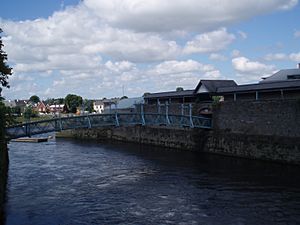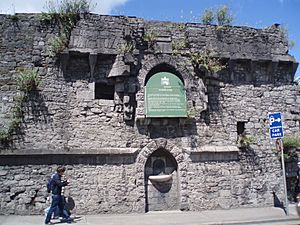King's Island, Limerick facts for kids
King's Island (Irish: Oileán an Rí) is a special part of central Limerick, Ireland. People often call it The Island. It has two main areas: Englishtown and St Mary's Park. Englishtown is the older, historic part of Limerick, found on the south side. St Mary's Park is a modern housing area on the north side.
The island is surrounded by the River Shannon. A smaller river, the Abbey River, splits off from the Shannon. It then flows around the island before joining the Shannon again near the Potato Market.
The island likely got its name from the famous King John's Castle. This castle was built in the 13th century by an English king. However, an old map from 150 AD by Ptolemy shows a place called 'Regia' here. This suggests people lived on the island even before the castle was built. The island's location was perfect for defense and crossing the river.
Exploring Englishtown: Limerick's Historic Heart
Long ago, the entire city of Limerick was inside the walls of what is now Englishtown. It was a walled city. The Vikings first built a settlement here after they came to Ireland. Later, after the Norman Invasion of Ireland, Norman or Old English settlers took over the city.
This is why the area became known as Englishtown. It helped tell it apart from Irishtown across the Abbey River, where native Irish people lived. During the Norman period, many important buildings were constructed here. These include the 13th-century King John's Castle and the 800-year-old St Mary's Cathedral.
Nicholas Street and Mary Street were the main streets of Limerick in medieval times. They are probably the oldest streets in the city. In 1837, Samuel Lewis wrote that old Limerick in Englishtown looked like the city of Rouen in France. The houses were built in a style similar to those in Flanders.
Over time, Englishtown became less popular. The city's main area moved south to Newtown Pery. The old, crowded houses in Englishtown were later replaced with new buildings in the 20th century. This meant some historic structures were lost.
In recent years, the King's Island and Englishtown areas have been improved. They are now a popular place for tourists. People come to see the important historical sites and learn about the area's rich past.
St Mary's Park: A Modern Community
St Mary's Park is a housing area. It is located on the northern part of King's Island, sometimes called the Island Field. This area is part of a bigger plan to improve Limerick city. The project aims to rebuild and better connect the estate with the rest of the city.
Famous Landmarks on King's Island
King's Island and Englishtown are the oldest parts of Limerick. They are home to many important buildings and landmarks. Here are some of them:
- King John's Castle, on Castle Street, built in the 13th Century.
- St Mary's Cathedral, on Bridge Street, dating from the 14th Century.
- Old Bishop's Palace, now the main office for Limerick Civic Trust, built around 1750.
- St Munchin's Church, now home to the Island Theatre Company, built around 1825.
- Villier's Almshouses, on Verdant Place, built around 1820.
- (Royal) Military Cemetery, on King's Island, started in 1856.
- Bourke's Castle, on Athlunkard Street.
- Fanning's Castle, on Mary Street, built around 1641.
- City Courthouse, on Merchants Quay, built around 1800.
- Barrington's Hospital, on George's Quay.
- St Mary's Roman Catholic Church, on Athlunkard Street.
- Exchange Walls, which were once part of the Exchange Building, on Nicholas Street.
- Ruins of the old Dominican Friary, on Bishop Street.
- Limerick City Hall & Civic Buildings, on Merchants Quay.
- Baal's Bridge, built in 1830. It replaced an older bridge that connected Irishtown to Englishtown long ago. A very old brass square, possibly from 1517, was found when the new bridge was built. It is thought to be one of the oldest items linked to Freemasonry found anywhere.






